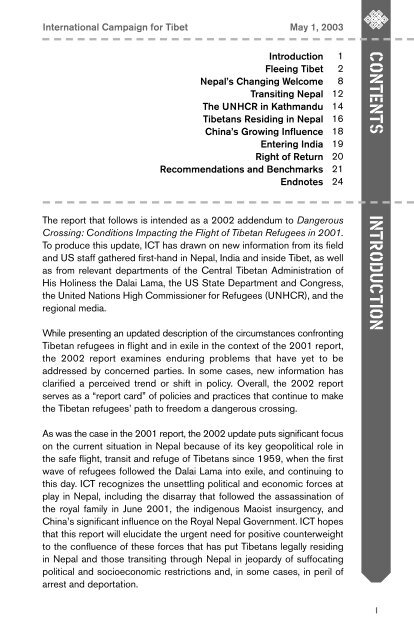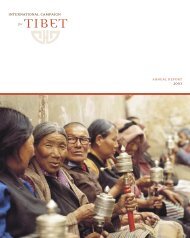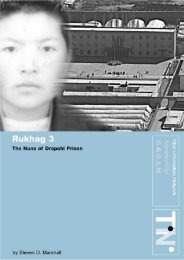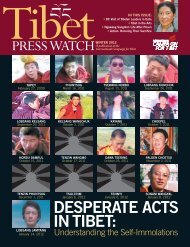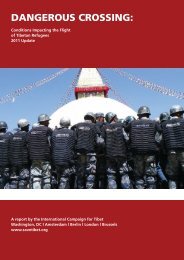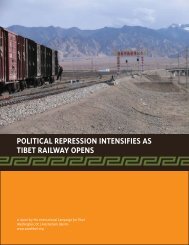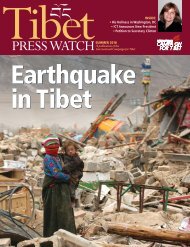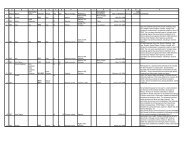download the report - International Campaign for Tibet
download the report - International Campaign for Tibet
download the report - International Campaign for Tibet
- No tags were found...
You also want an ePaper? Increase the reach of your titles
YUMPU automatically turns print PDFs into web optimized ePapers that Google loves.
<strong>International</strong> <strong>Campaign</strong> <strong>for</strong> <strong>Tibet</strong>May 1, 2003IntroductionFleeing <strong>Tibet</strong>Nepal’s Changing WelcomeTransiting NepalThe UNHCR in Kathmandu<strong>Tibet</strong>ans Residing in NepalChina’s Growing InfluenceEntering IndiaRight of ReturnRecommendations and BenchmarksEndnotes1281214161819202124CONTENTSThe <strong>report</strong> that follows is intended as a 2002 addendum to DangerousCrossing: Conditions Impacting <strong>the</strong> Flight of <strong>Tibet</strong>an Refugees in 2001.To produce this update, ICT has drawn on new in<strong>for</strong>mation from its fieldand US staff ga<strong>the</strong>red first-hand in Nepal, India and inside <strong>Tibet</strong>, as wellas from relevant departments of <strong>the</strong> Central <strong>Tibet</strong>an Administration ofHis Holiness <strong>the</strong> Dalai Lama, <strong>the</strong> US State Department and Congress,<strong>the</strong> United Nations High Commissioner <strong>for</strong> Refugees (UNHCR), and <strong>the</strong>regional media.While presenting an updated description of <strong>the</strong> circumstances confronting<strong>Tibet</strong>an refugees in flight and in exile in <strong>the</strong> context of <strong>the</strong> 2001 <strong>report</strong>,<strong>the</strong> 2002 <strong>report</strong> examines enduring problems that have yet to beaddressed by concerned parties. In some cases, new in<strong>for</strong>mation hasclarified a perceived trend or shift in policy. Overall, <strong>the</strong> 2002 <strong>report</strong>serves as a “<strong>report</strong> card” of policies and practices that continue to make<strong>the</strong> <strong>Tibet</strong>an refugees’ path to freedom a dangerous crossing.INTRODUCTIONAs was <strong>the</strong> case in <strong>the</strong> 2001 <strong>report</strong>, <strong>the</strong> 2002 update puts significant focuson <strong>the</strong> current situation in Nepal because of its key geopolitical role in<strong>the</strong> safe flight, transit and refuge of <strong>Tibet</strong>ans since 1959, when <strong>the</strong> firstwave of refugees followed <strong>the</strong> Dalai Lama into exile, and continuing tothis day. ICT recognizes <strong>the</strong> unsettling political and economic <strong>for</strong>ces atplay in Nepal, including <strong>the</strong> disarray that followed <strong>the</strong> assassination of<strong>the</strong> royal family in June 2001, <strong>the</strong> indigenous Maoist insurgency, andChina’s significant influence on <strong>the</strong> Royal Nepal Government. ICT hopesthat this <strong>report</strong> will elucidate <strong>the</strong> urgent need <strong>for</strong> positive counterweightto <strong>the</strong> confluence of <strong>the</strong>se <strong>for</strong>ces that has put <strong>Tibet</strong>ans legally residingin Nepal and those transiting through Nepal in jeopardy of suffocatingpolitical and socioeconomic restrictions and, in some cases, in peril ofarrest and deportation.1


